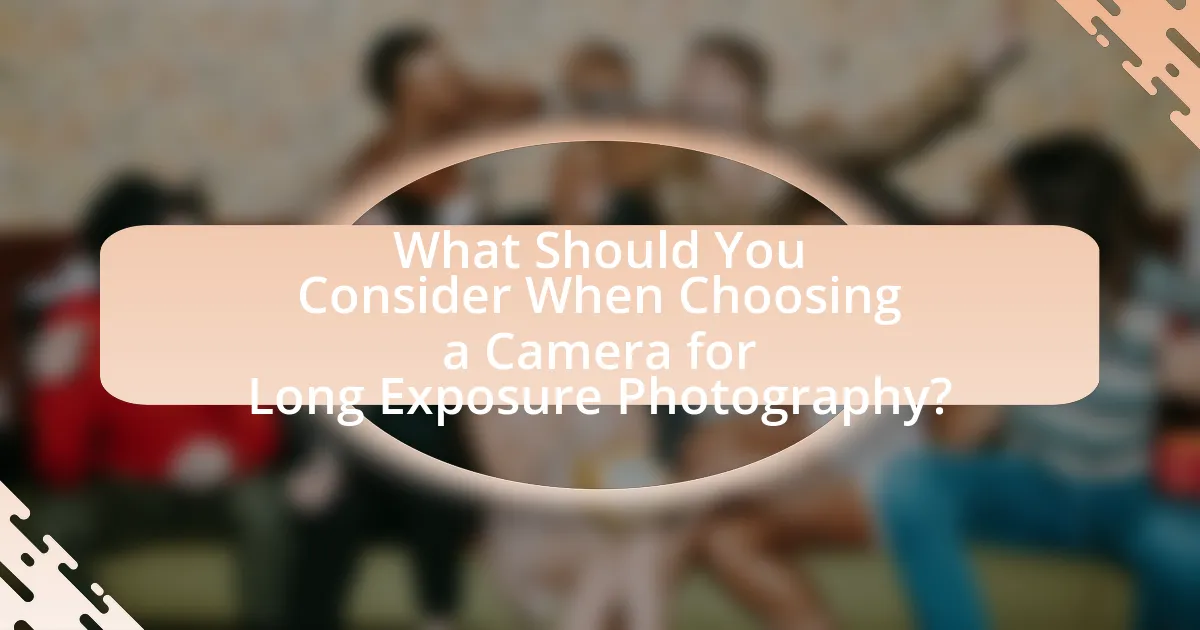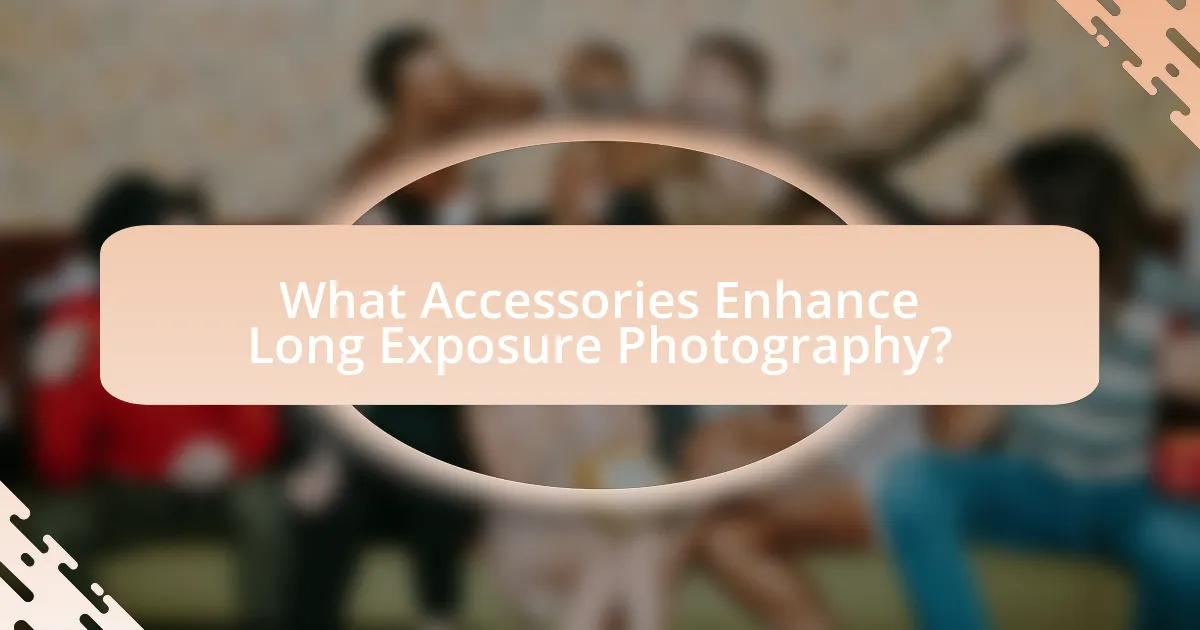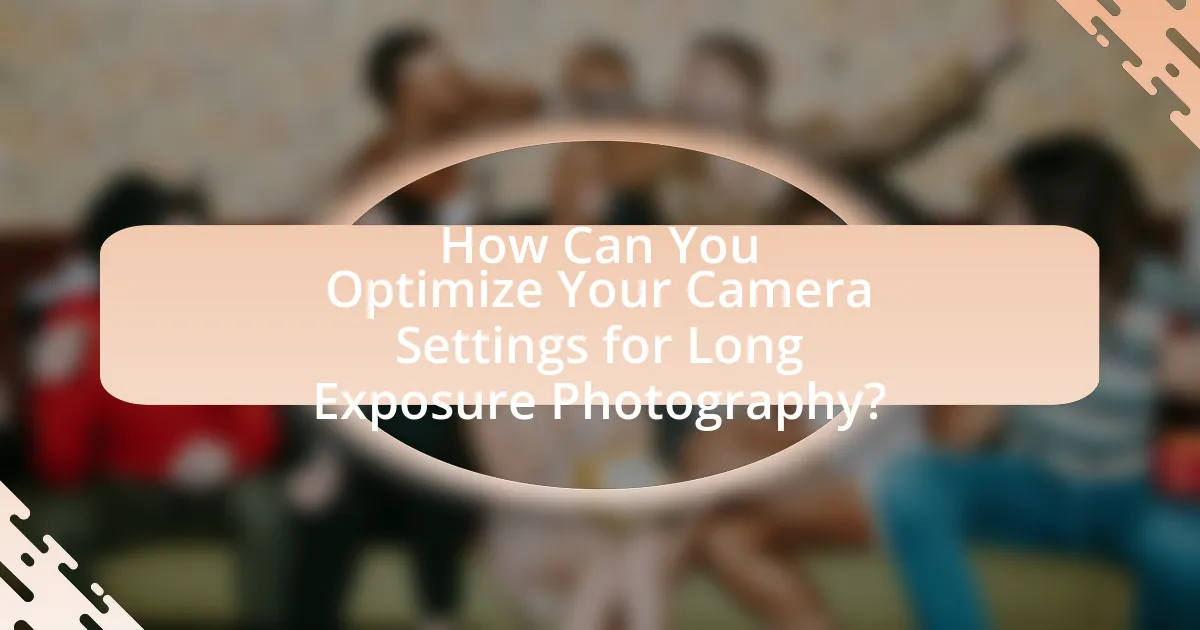The article focuses on selecting the best camera for long exposure photography, emphasizing the importance of manual settings and low noise performance. It discusses how sensor size affects image quality, particularly in low-light conditions, and compares full-frame and crop sensors. Essential features for long exposure photography, such as sturdy tripods, remote shutter releases, and neutral density filters, are highlighted, along with optimal camera settings and techniques to enhance results. The article also addresses common mistakes to avoid and best practices for composition, ensuring photographers can achieve high-quality long exposure images.

What Should You Consider When Choosing a Camera for Long Exposure Photography?
When choosing a camera for long exposure photography, prioritize a camera with manual settings and low noise performance. Manual settings allow for precise control over exposure time, aperture, and ISO, which are crucial for achieving desired effects in long exposure shots. Low noise performance is essential because longer exposures can amplify sensor noise, degrading image quality. Cameras with larger sensors, such as full-frame models, typically exhibit better noise control, especially at higher ISO settings. Additionally, consider the availability of features like bulb mode, which enables exposures longer than the standard maximum, and image stabilization, which can help reduce blur from camera shake during extended exposures.
How does sensor size impact long exposure photography?
Sensor size significantly impacts long exposure photography by influencing image quality, noise levels, and dynamic range. Larger sensors, such as full-frame sensors, capture more light, resulting in better detail and less noise during extended exposures compared to smaller sensors like crop sensors. This is particularly important in low-light conditions, where larger sensors can maintain image clarity and color accuracy. Studies show that full-frame sensors can produce images with a dynamic range of up to 14 stops, while smaller sensors may only achieve around 10 stops, affecting the ability to capture highlights and shadows effectively. Thus, for long exposure photography, a larger sensor is generally preferred for superior performance and image quality.
What are the differences between full-frame and crop sensors?
Full-frame sensors are larger than crop sensors, measuring approximately 36mm x 24mm compared to the crop sensor’s dimensions, which typically range from 22mm x 15mm to 18mm x 12mm. This size difference results in full-frame sensors capturing more light, providing better low-light performance and dynamic range. Additionally, full-frame sensors offer a wider field of view, which is beneficial for landscape and long exposure photography, allowing for more expansive compositions. The crop factor of crop sensors, usually around 1.5x to 1.6x, effectively multiplies the focal length of lenses, making them appear longer, which can be advantageous for wildlife photography but limits the wide-angle capabilities.
How does sensor size affect image quality in low light?
Sensor size significantly affects image quality in low light conditions, with larger sensors typically producing better results. Larger sensors have a greater surface area to capture light, which enhances their ability to gather more photons, resulting in improved sensitivity and reduced noise levels. For instance, full-frame sensors can capture more detail and maintain clarity at higher ISO settings compared to smaller sensors like those found in crop-frame cameras. This is supported by studies showing that larger sensors yield lower noise levels and better dynamic range in low light scenarios, making them preferable for long exposure photography.
What features are essential for long exposure photography?
Essential features for long exposure photography include a sturdy tripod, manual exposure settings, and a low ISO capability. A sturdy tripod stabilizes the camera during extended exposure times, preventing blurriness from camera shake. Manual exposure settings allow photographers to control shutter speed, aperture, and ISO, which are critical for achieving the desired effect in long exposures. A low ISO capability minimizes noise in images, which is particularly important during longer exposures where noise can become more pronounced. These features collectively enhance the quality and effectiveness of long exposure photography.
Why is manual mode important for long exposure shots?
Manual mode is important for long exposure shots because it allows photographers to have complete control over exposure settings, including shutter speed, aperture, and ISO. This control is essential for achieving the desired effects in long exposure photography, such as capturing motion blur or light trails, which require specific shutter speeds that cannot be set in automatic modes. For instance, a longer shutter speed can result in smoother water surfaces or illuminated light paths, while adjusting the aperture can influence depth of field and overall exposure. Therefore, using manual mode ensures that photographers can fine-tune these settings to match their creative vision and the specific lighting conditions of the scene.
How do shutter speed and aperture settings influence exposure?
Shutter speed and aperture settings directly influence exposure by controlling the amount of light that reaches the camera sensor. Shutter speed determines how long the sensor is exposed to light; a faster shutter speed allows less light in, resulting in a darker image, while a slower shutter speed permits more light, leading to a brighter image. Aperture, measured in f-stops, controls the size of the lens opening; a wider aperture (lower f-stop number) lets in more light, enhancing brightness, whereas a narrower aperture (higher f-stop number) reduces light intake, darkening the image. Together, these settings create a balance that affects the overall exposure, allowing photographers to achieve desired effects in their images.
What types of cameras are best suited for long exposure photography?
DSLR and mirrorless cameras are best suited for long exposure photography due to their ability to manually control exposure settings and use interchangeable lenses. These cameras typically feature larger sensors, which capture more light, resulting in better image quality during extended exposure times. Additionally, they allow for the use of neutral density filters, which further enhance long exposure capabilities by reducing the amount of light entering the lens. This combination of features makes DSLRs and mirrorless cameras ideal for capturing stunning long exposure images, such as those of waterfalls, night skies, and light trails.
What advantages do DSLRs offer for long exposure photography?
DSLRs offer several advantages for long exposure photography, primarily due to their larger sensors and manual control capabilities. The larger sensors in DSLRs capture more light, resulting in better image quality and reduced noise during extended exposure times. Additionally, DSLRs provide full manual control over settings such as aperture, shutter speed, and ISO, allowing photographers to fine-tune their images for optimal results. This level of control is essential for achieving the desired effects in long exposure shots, such as smooth water or light trails. Furthermore, many DSLRs feature robust build quality and weather sealing, which enhances their durability in various shooting conditions, making them suitable for outdoor long exposure photography.
How do mirrorless cameras compare for this type of photography?
Mirrorless cameras excel in long exposure photography due to their electronic viewfinders and silent shooting capabilities. The electronic viewfinder allows photographers to see the exposure in real-time, making it easier to compose shots accurately during long exposures. Additionally, the lack of a mechanical shutter reduces vibrations, which can lead to sharper images. Studies show that mirrorless systems often have faster autofocus and better low-light performance, enhancing their effectiveness for capturing long exposure scenes.

What Accessories Enhance Long Exposure Photography?
Tripods are essential accessories that enhance long exposure photography by providing stability and preventing camera shake during extended shutter speeds. A sturdy tripod allows photographers to capture sharp images over several seconds or minutes, which is crucial for techniques like capturing smooth water or light trails. Additionally, neutral density (ND) filters are beneficial as they reduce the amount of light entering the lens, enabling longer exposure times without overexposing the image. This combination of a reliable tripod and ND filters significantly improves the quality and creativity of long exposure shots.
How does a tripod contribute to long exposure photography?
A tripod stabilizes the camera during long exposure photography, preventing any movement that could cause blurriness. This stability is crucial because long exposure times, often ranging from several seconds to minutes, amplify the effects of even the slightest vibrations. Research indicates that using a tripod can reduce camera shake significantly, allowing for sharper images and better detail retention in low-light conditions.
What features should you look for in a tripod for stability?
When selecting a tripod for stability, prioritize features such as a sturdy build material, a wide base, adjustable leg angles, and a reliable locking mechanism. A sturdy build material, like aluminum or carbon fiber, ensures durability and minimizes vibrations. A wide base enhances stability by distributing weight evenly, which is crucial for long exposure photography. Adjustable leg angles allow for versatility on uneven terrain, maintaining stability in various shooting conditions. A reliable locking mechanism secures the legs in place, preventing accidental shifts during use. These features collectively contribute to a stable platform essential for capturing sharp images during long exposure.
Why is a remote shutter release beneficial for long exposures?
A remote shutter release is beneficial for long exposures because it minimizes camera shake, which can lead to blurred images. When taking long exposure photographs, even the slightest movement can affect the sharpness of the image. By using a remote shutter release, photographers can trigger the camera without physically touching it, thus maintaining stability. This technique is particularly important in long exposure scenarios, where the shutter is open for extended periods, often several seconds to minutes. Studies in photography emphasize that reducing vibrations is crucial for achieving clear and crisp images during such lengthy exposures.
What filters are useful for long exposure photography?
Neutral Density (ND) filters are essential for long exposure photography as they reduce the amount of light entering the lens without affecting color balance. This allows photographers to use slower shutter speeds, which is crucial for capturing motion blur in elements like water or clouds. ND filters come in various strengths, typically measured in stops, with common options being 3-stop, 6-stop, and 10-stop filters. For example, a 10-stop ND filter can enable exposures that are 1024 times longer than without the filter, facilitating dramatic effects in bright conditions.
How do neutral density filters affect exposure time?
Neutral density filters reduce the amount of light entering the camera, allowing for longer exposure times without overexposing the image. By decreasing light intensity, these filters enable photographers to use slower shutter speeds, which is essential for capturing motion blur or achieving a specific depth of field in bright conditions. For example, a 10-stop neutral density filter can increase exposure time by a factor of 1,024, meaning a 1-second exposure could be extended to over 17 minutes, facilitating creative effects in long exposure photography.
What types of filters should you consider for different lighting conditions?
For different lighting conditions, you should consider using neutral density (ND) filters, polarizing filters, and graduated ND filters. ND filters reduce the amount of light entering the lens, allowing for longer exposure times in bright conditions without overexposing the image. Polarizing filters help manage reflections and enhance color saturation, making them ideal for shooting in bright sunlight or near water. Graduated ND filters are useful for balancing exposure between a bright sky and a darker foreground, particularly during sunrise or sunset. These filters are essential tools for achieving optimal results in varying lighting scenarios during long exposure photography.

How Can You Optimize Your Camera Settings for Long Exposure Photography?
To optimize your camera settings for long exposure photography, set your camera to manual mode, use a low ISO (100 or 200), select a small aperture (f/8 to f/16), and adjust the shutter speed to achieve the desired exposure time. Manual mode allows full control over settings, while a low ISO minimizes noise, and a small aperture increases depth of field and sharpness. For long exposures, shutter speeds can range from several seconds to minutes, depending on the scene and desired effect, such as capturing motion blur in water or light trails. These settings are validated by photography guidelines that emphasize the importance of controlling light and motion for effective long exposure results.
What camera settings are crucial for successful long exposure shots?
The crucial camera settings for successful long exposure shots include a low ISO, a small aperture, and a slow shutter speed. A low ISO, typically around 100, minimizes noise and enhances image quality. A small aperture, such as f/8 to f/16, increases depth of field and sharpness. A slow shutter speed, often several seconds to minutes, allows for the capture of motion blur and light trails. These settings work together to create the desired effects in long exposure photography, ensuring clarity and artistic expression in the final image.
How do ISO settings impact image quality during long exposures?
ISO settings significantly impact image quality during long exposures by influencing noise levels and dynamic range. Higher ISO settings increase sensitivity to light, which can lead to greater noise, particularly in low-light conditions typical of long exposures. Research indicates that noise levels can double with each full stop increase in ISO, resulting in a grainy appearance that detracts from image quality. Conversely, lower ISO settings reduce noise but may require longer exposure times to achieve the same brightness, which can introduce motion blur if the camera is not stable. Therefore, selecting an appropriate ISO is crucial for balancing exposure time and maintaining image clarity in long exposure photography.
What is the ideal aperture setting for long exposure photography?
The ideal aperture setting for long exposure photography is typically between f/8 and f/16. This range allows for a good balance between depth of field and light intake, ensuring that the image remains sharp while preventing overexposure during extended exposure times. Using an aperture within this range helps to achieve optimal sharpness and clarity, as lenses often perform best around these f-stops.
What techniques can improve your long exposure photography results?
To improve long exposure photography results, utilize a sturdy tripod to eliminate camera shake. A tripod stabilizes the camera during extended exposure times, which is crucial for capturing sharp images. Additionally, using a remote shutter release or the camera’s timer function minimizes vibrations caused by pressing the shutter button. Employing neutral density filters allows for longer exposure times in bright conditions, enabling creative effects like smooth water or cloud movement. Lastly, experimenting with different exposure times and settings can help achieve the desired artistic effect, as varying the duration can significantly alter the final image.
How can you use bracketing to enhance dynamic range?
Bracketing can enhance dynamic range by capturing multiple exposures of the same scene at different exposure levels. This technique allows photographers to combine the best parts of each exposure, resulting in a final image that retains detail in both highlights and shadows. For instance, by taking one underexposed, one correctly exposed, and one overexposed shot, photographers can merge these images using software like Adobe Lightroom or Photoshop, effectively increasing the dynamic range beyond what a single exposure could achieve. This method is particularly useful in high-contrast situations, where the difference between the brightest and darkest areas is significant, ensuring that no detail is lost in the final image.
What are the best practices for composing long exposure shots?
The best practices for composing long exposure shots include selecting a stable tripod, using a remote shutter release or timer, and choosing the right composition with leading lines and focal points. A stable tripod prevents camera shake, which is crucial for capturing sharp images during extended exposure times. A remote shutter release or timer minimizes vibrations caused by pressing the shutter button, ensuring clarity in the final image. Additionally, effective composition techniques, such as incorporating leading lines and strong focal points, enhance the visual impact of the photograph, guiding the viewer’s eye through the scene. These practices are essential for achieving high-quality long exposure photographs.
What common mistakes should you avoid in long exposure photography?
Common mistakes to avoid in long exposure photography include not using a sturdy tripod, which can lead to camera shake and blurred images. Additionally, failing to use a remote shutter release or timer can introduce vibrations during the shot. Not considering the exposure time can result in overexposed or underexposed images, while neglecting to check for light pollution can affect image quality. Lastly, forgetting to use a neutral density filter can limit the ability to achieve longer exposures in bright conditions. Each of these mistakes can significantly impact the final outcome of long exposure photographs.
How can you prevent camera shake during long exposures?
To prevent camera shake during long exposures, use a sturdy tripod to stabilize the camera. A tripod minimizes movement and vibrations, which are critical during extended shutter speeds. Additionally, employing a remote shutter release or the camera’s self-timer feature can further reduce shake by eliminating the need to physically press the shutter button, which can introduce motion. Research indicates that even slight movements can lead to noticeable blurriness in images taken with exposure times longer than one second, reinforcing the importance of stability in long exposure photography.
What should you watch out for when using filters?
When using filters, you should watch out for potential image quality degradation. Filters can introduce issues such as lens flare, reduced sharpness, and color cast, which can negatively affect the overall quality of long exposure photographs. For instance, using a low-quality filter may result in noticeable distortion or loss of detail, particularly in high-contrast scenes. Additionally, certain filters can cause vignetting, where the corners of the image appear darker than the center, impacting the composition. Therefore, selecting high-quality filters and understanding their effects on image quality is crucial for achieving optimal results in long exposure photography.